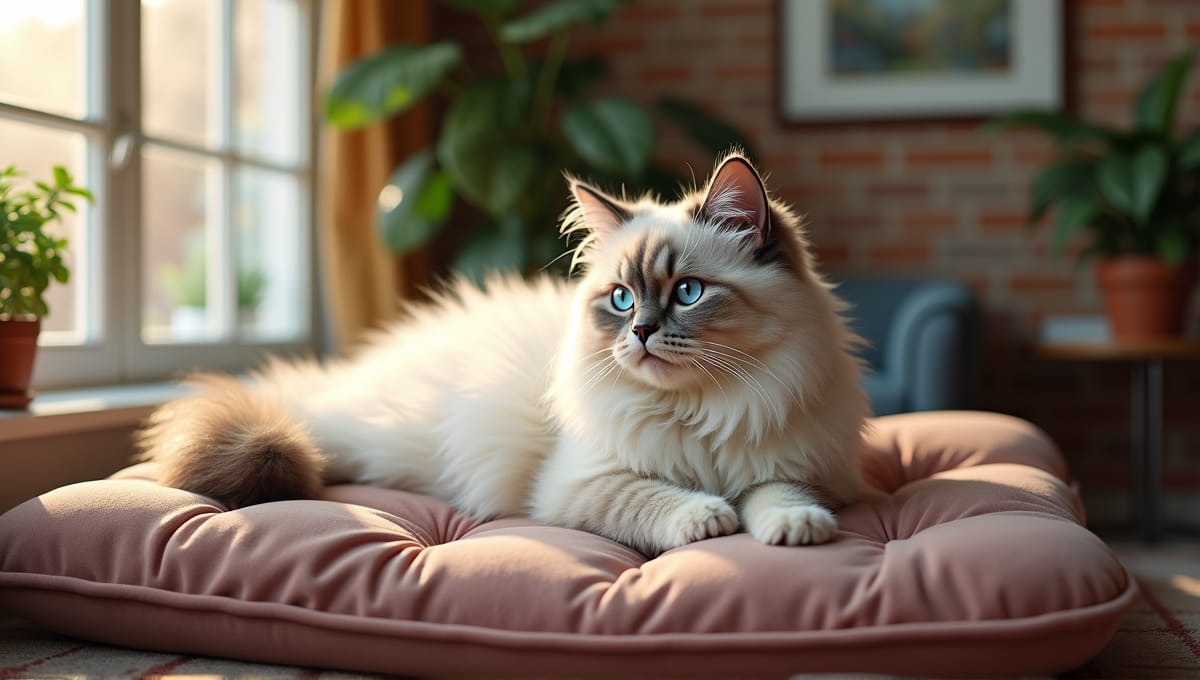Japanese Bobtails are interesting cats with a long history and some unique characteristics. I’ve researched Japanese Bobtails for years, and one of the most obvious things that distinguishes them from other breeds is their unique, short tails. However, there are other reasons Japanese Bobtails are special.
Physical Characteristics of Japanese Bobtail Cats

Japanese Bobtails are a unique breed with a few distinguishing features. The most obvious of these features is their bobbed tail. Their tail is usually less than 10 cm (3.9 in) long. This feature is the result of a dominant gene that is fixed in the breed. The tail can be kinked, curved, or bumpy. It is a key feature of the breed as no two tails are identical!
They have a medium, muscular body. Japanese Bobtails are moderately sized cats with a sturdy build. They have longer legs and a slim body. Their coat can be short or long and is soft and silky to the touch. Additionally, their coat comes in many colors and patterns, so you will find a Japanese Bobtail to fit nearly any color and pattern preference. You will see:
- solid colors
- parti-colors
- calico patterns
They have triangular faces with high cheekbones. Their eyes are one of their most outstanding features. They are large, almond-shaped, and a bit of a slant. Their eye color can be:
- gold
- copper
- green
- odd-eyed (two different colored eyes)
Their ears are quite large and tilt out slightly, which adds to the alert expression these cats often wear.
Scientific studies have shown Japanese Bobtails are one of the most genetically diverse cat breeds. This makes them a healthy breed with a variety of appearances. Learn more about other Chinese cat breeds that also have unique characteristics.
Temperament and Character of Japan’s Tailless Cat
I’ve studied Japanese Bobtails for years. They’re active, playful cats that enjoy participating in family activities. They are known for following their owners around the house while making chirping and trilling sounds.
They’re intelligent cats that pick up tricks easily and enjoy playing with puzzle toys. I’ve even seen them learn how to open doors and cabinets. Their intelligence also makes them easy to train.
Japanese Bobtails are very vocal and have a wide range of vocalizations from quiet chirps to loud meows. They use these various sounds to talk to their owners and it really does sound like they’re having a conversation with you.
They’re very social cats and they’re happy to live with humans, other cats, and even dogs. In my experience, they also get along well with children. Japanese Bobtails thrive on social interaction and they don’t like to be left alone for long periods of time.
- Adult Japanese Bobtails typically weigh 6-9 pounds.
- With proper care, they usually live 9-15 years.
The Genesis and Evolution of Japan’s Native Short-Tailed Cat
The Japanese Bobtail has a long history in Japan. Cats likely came to Japan with Buddhist monks in the 6th century. The first recorded mention of a cat in Japan dates back to a diary entry from Emperor Uda in 889 AD.
These cats have a strong presence in Japanese culture, appearing in folklore and art.
- The Maneki-neko, or beckoning cat, which is often depicted as the Japanese Bobtail, is an excellent example of this.
- Many people believe this figure brings good fortune.
The breed naturally evolved in Japan over thousands of years.
- People valued cats for their natural mouse-catching abilities in silk factories and temples.
- The reason many of these cats have a bobtail is likely due to natural selection and possibly human preference.
The breed began attracting attention in the West in the mid-20th century.
- When cat fanciers visited Japan, they were fascinated by these cats with unique tails and brought them to the Western world.
Japanese Bobtail Breed Recognition and Standards

The breed’s path to official recognition began in the 1960s. Elizabeth Freret brought the first Japanese Bobtails to the US in 1968. This was a significant step toward the breed’s international recognition.
Finally, major cat associations began accepting the Japanese Bobtail.
- The CFA recognized Japanese Bobtails in 1976.
- TICA soon followed in 1979.
Breed standards emphasize unique characteristics of the Japanese Bobtail.
- The tail is obviously a critical characteristic. It should be clearly visible and will extend to no longer than an inch or less.
- The body should also be long, lean, and muscular.
Show categories are divided by variety (longhair and shorthair). Judges evaluate
- balance,
- type,
- and overall health of the cat.
- The cat’s temperament is also evaluated by the judges.
There are some variations in the standards between the US and Japan.
- In Japan, they still focus more on traditional colors and patterns.
- In the US, breeders have worked to develop a broader range of colors and patterns.
Caring for a Unique Short-Tailed Feline Breed
Japanese Bobtails are generally healthy cats. Their genetic diversity contributes to this. However like all breeds they can be prone to certain health issues. Regular vet check-ups are essential.
Grooming needs depend on coat length.
- Shorthaired cats need weekly brushing.
- Longhaired cats may need daily grooming to prevent matting.
Their coat doesn’t mat as easily as some other longhaired breeds.
A balanced diet is crucial for their health.
- High-quality cat food that meets their nutritional needs is important.
- Portion control is key to prevent obesity.
- Fresh water should always be available.
These active cats need plenty of exercise.
- Provide climbing trees, interactive toys and play sessions.
Mental stimulation is as important as physical exercise for this intelligent breed.
Japanese Bobtails have smaller litters with larger kittens.
- These kittens develop faster than average.
- Kitten mortality rates are reportedly low for this breed.
This contributes to their overall hardiness.
Genetic Uniqueness of Japanese Bobtail
Japanese Bobtails are notable in genetic studies. They’re one of the most genetically diverse pedigree cat breeds. This genetic diversity is one reason they’re a healthy breed with unique characteristics.
The bobtail mutation is interesting. A study in 2016 discovered a missense mutation of the HES7 gene that results in kinked tails in Japanese Bobtails. Interestingly, this mutation is the same in cats from Southeast Asia through China.
The bobtail gene is a dominant gene. Therefore, only one copy of the gene is required for a cat to have a bobtail. To ensure the breed remains healthy and genetically diverse, responsible breeders conduct genetic health screenings.
While there are other bobtail breeds, such as the Manx or Kurilian Bobtail, the genetic mutation that makes their tail short is different from the one in Japanese Bobtails. Therefore, Japanese Bobtails are the only breed of cat with this specific bobtail gene mutation.
Learn more about exotic cat breeds that might also be a good fit for your family.
Japanese Bobtail in Modern Culture
Japanese Bobtails have become popular worldwide. Their playful personality and distinct look make them excellent pets. They are particularly common in Japan and the United States.
You’ll often see these cats in Japanese art and media. For instance, the “Maneki-neko,” or beckoning cat figurine, is a popular cultural symbol that is often modeled after the Japanese Bobtail.
Some Japanese Bobtails have become household names. For example,
- “Socks,” a calico Japanese Bobtail, was owned by former U.S. President Bill Clinton.
This increased the breed’s popularity in the United States.
There are breed clubs and organizations dedicated to honoring these cats. They organize shows,
- gatherings,
- educational resources.
These organizations are critical to the promotion and preservation of the breed.
To Sum It Up
Japanese Bobtails are intriguing cats with a long history and some interesting characteristics. Their peculiar little pom-pom tails and playful nature make them a favorite. I’ve had the pleasure of caring for multiple Japanese Bobtails, and they’re incredibly smart and delightful cats.
They’re more than just pets – they’re loyal companions that will inject happiness and vigor into your home. Just ensure you take them to the vet annually and feed them a good diet, and you’ll have a healthy Japanese Bobtail. It really is fascinating how these cats essentially represent hundreds of years of Japanese culture and selective breeding today.






